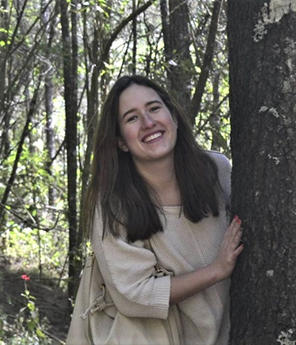What drew you to the University of Kentucky graduate program?
 I have a Licenciatura degree in archaeology from the Universidad Veracruzana in Mexico, my country of origin, obtained in May 2016. I moved to the United States in 2017, when I was accepted to the Ph.D. program in Anthropology with a Research Excellence stipend at the University of Kentucky.
I have a Licenciatura degree in archaeology from the Universidad Veracruzana in Mexico, my country of origin, obtained in May 2016. I moved to the United States in 2017, when I was accepted to the Ph.D. program in Anthropology with a Research Excellence stipend at the University of Kentucky.
I have been part of several archaeological projects in Mexico since 2013 as an undergraduate and graduate student. At the Eastern Lower Papaloapan Basin, where I focus on for my dissertation research, I was part of all the field and laboratory seasons of the Recorrido Regional Arqueológico Tres Zapotes project (Tres Zapotes Regional Archaeological Survey, RRATZ), directed by University of Kentucky professor Christopher Pool and staff archaeologist Michael Loughlin. My interest in populations under Aztec and Spanish imperial control emerged while I was working for this project, and I chose to pursue this research in a Ph.D. program at UK with Pool as my adviser.
Describe the research you are conducting and the professor who is your primary mentor.
My adviser is Christopher Pool, a prominent researcher in the archaeology of the Mexican Gulf Coast. Pool is a full professor in the Department of Anthropology, and he has conducted several archaeological projects over more than 30 years in Mexico. His research encompasses a broad range of themes, including long-term change in economic and political organization, historical ecology, culture contact and the evolution of social complexity. The research I am conducting under his supervision focuses on an archaeological assessment of changes in quality of life of indigenous populations to measure economic impacts of the contact period in Mexico, exploring how alterations in access to agricultural land affected native communities after European conquest.
The goal of this dissertation project is to contribute to a more nuanced understanding of how colonialism and its economic enterprises affected indigenous people and their everyday provisioning. This research problem is addressed comparing local adaptations to the Mexican and Spanish political and economic systems through data to be obtained in excavations at two sites of the ELPB: Mazapa and La Sierra. The project will contribute to anthropological understandings of culture contact, developing an approach through household quality of life that affords the possibility of identifying local and socioeconomic variation in the impact of colonialism.
So far, I have had two seasons of predissertation work. In the first season (2018), I conducted archival research in Mexico City and Xalapa, where I analyzed 16th-century maps and located the archaeological communities found by the RRATZ project, confirming their correspondence with colonial occupations. In the second season (2019) I performed laboratory work at the Tres Zapotes Museum in the Eastern Lower Papaloapan Basin, which stores the regional archaeological materials. There, I refined the regional ceramic catalogue for the Postclassic to colonial period. The next step in my dissertation project is to conduct excavations at the sites proposed.
Have you benefitted from any internships, presentations at conferences, research travel or study abroad opportunities?
My predissertation research has been supported by several awards and research grants, including the UK Anthropology Research Excellence stipend; two UK Odear awards; The Susan-Abbott Jamieson Research grant; two Latin American, Caribbean and Latino Studies research grants; and the Halperin Award, which is a world-wide competitive grant by the Society of Economic Anthropology (SEA). I have presented my Ph.D. research in national and international conferences, including several Society for American Archaeology (SAA) annual meetings, the International Congress of Americanists, the American Anthropological Association and other regional symposia such as the Latin American, Caribbean and Latino Studies symposium and the Midwest Mesoamerican Conference. Last spring, I was part of the University of Kentucky team for the SAA international archaeological ethics debate competition, winning first place. I have published a co-authored book chapter on the prehispanic occupations of the Eastern Lower Papaloapan Basin (Pool et. Al. 2017),and public-oriented chapters about the osteological and codex collections of the Anthropology Museum of Xalapa (MAX, Cuevas and Montero 2019).
Please explain how receiving this scholarship or fellowship has impacted your graduate study today and how you see it potentially affecting your future.
I am immensely grateful to the donor(s) of the Odear award as well as to the NSF, which are allowing me to conduct fieldwork in Mexico. One of the difficulties for timely progress when conducting archaeological research internationally is that heritage is legally protected by its country of origin. In my case, Mexican law does not permit the archaeological collections that are recovered in excavations to travel outside of the country, and the analysis of such collections takes several months. This fall semester, I am conducting archaeological research at three sites spanning the Aztec to colonial transition, and I will analyze the archaeological artifacts recovered in my excavations.
The money will allow me to recover data for my doctoral dissertation, but it will mainly benefit my career through allowing me to develop the necessary skills to direct an archaeological research project, with guidance of Pool. My career goals are oriented towards impactful research, emphasizing the relationship between science and public outreach. My dissertation project therefore has a strong focus on knowledge dissemination and communication. The Odear award will allow me to start writing my dissertation in the spring of 2022, finishing my degree in a total of five years. Thank you: I never could have done it without this support.
